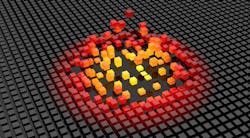Ayar Labs partners with GLOBALFOUNDRIES for optical I/O demo, expanded sampling for co-packaged optics
Ayar Labs says it has successfully demonstrated its patented optical I/O technology using GLOBALFOUNDRIES’ next-generation 45-nm process platform. The demonstration with one of Ayar Labs’ strategic investors (see “Optical interconnect startup Ayar Labs closes $35 million Series B funding round”) marks the beginning of an expanded phase of sampling for 2021. The company will report the results of the demonstration at next week’s ECOC 2020 virtual event December 8, from 16:20 to 16:40 CET.
The company’s optical I/O approach features 5x9-mm silicon chiplets that contain such optical transceiver functions as modulation, clocking, multiplexing, etc., paired with disaggregated lasers, according to Hugo Saleh vice president of business development and marketing at Ayar Labs. The chiplets, which feature micro-ring resonator-based modulation capabilities, are designed to be integrated within the packaging of the semiconductor for which they provide I/O via a multi-chip module approach. The semiconductor developer can perform this co-packaging using their normal processes, whether in-house or third-party, Saleh said.
The SuperNova disaggregated lasers, meanwhile, do not have to be co-resident with the chiplets – or even with the system that houses the host semiconductor, Saleh said. System designers and/or their network operator customers may want to house them where they can be more readily and inexpensively cooled, for example. The laser/chiplet combination is designed to support transmission distances of 2 km – which would include the distance between the lasers and the chiplet, according to Saleh. The chiplet/laser combination currently can provide as much as 2 Tbps of transmission capacity with a roadmap toward more, he added.
The selection of configuration scheme clearly requires close collaboration between Ayar Labs and potential customers. Saleh says such engagements are already underway; the company’s work with Intel (another investor via Intel Capital) is already public. The engagements focus on three main applications, according to Saleh: datacom and telecommunications networking, aerospace and government, and high-performance computing and artificial intelligence. Saleh said he expects the sampling work to lead to commercialization in what he called small volumes by the end of next year or the beginning of 2022.
For related articles, visit the Optical Technologies Topic Center.
For more information on optical components and suppliers, visit the Lightwave Buyer’s Guide.
To stay abreast of optical communications technology, subscribe to Lightwave’s Enabling Technologies Newsletter.

Stephen Hardy | Editorial Director and Associate Publisher, Lightwave
Stephen Hardy is editorial director and associate publisher of Lightwave and Broadband Technology Report, part of the Lighting & Technology Group at Endeavor Business Media. Stephen is responsible for establishing and executing editorial strategy across the both brands’ websites, email newsletters, events, and other information products. He has covered the fiber-optics space for more than 20 years, and communications and technology for more than 35 years. During his tenure, Lightwave has received awards from Folio: and the American Society of Business Press Editors (ASBPE) for editorial excellence. Prior to joining Lightwave in 1997, Stephen worked for Telecommunications magazine and the Journal of Electronic Defense.
Stephen has moderated panels at numerous events, including the Optica Executive Forum, ECOC, and SCTE Cable-Tec Expo. He also is program director for the Lightwave Innovation Reviews and the Diamond Technology Reviews.
He has written numerous articles in all aspects of optical communications and fiber-optic networks, including fiber to the home (FTTH), PON, optical components, DWDM, fiber cables, packet optical transport, optical transceivers, lasers, fiber optic testing, and more.
You can connect with Stephen on LinkedIn as well as Twitter.
